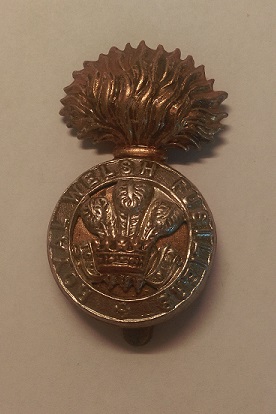
The Royal Welch Fusiliers (Welsh: Ffiwsilwyr Brenhinol Cymreig) was a line infantry regiment of the British Army, and part of the Prince of Wales's Division, that was founded in 1689; shortly after the Glorious Revolution. In 1702, it was designated a fusilier regiment and became the Welch Regiment of Fusiliers; the prefix "Royal" was added in 1713, then confirmed in 1714 when George I named it the Prince of Wales's Own Royal Regiment of Welsh Fusiliers. In 1751, after reforms that standardised the naming and numbering of regiments, it became the 23rd Regiment of Foot (Royal Welsh Fuzileers). In 1881, the final title of the regiment was adopted.

The Lancashire Fusiliers was a line infantry regiment of the British Army that saw distinguished service through many years and wars, including the Second Boer War, the First and Second World Wars, and had many different titles throughout its 280 years of existence. In 1968 the regiment was amalgamated with the other regiments of the Fusilier Brigade – the Royal Northumberland Fusiliers, Royal Warwickshire Fusiliers and the Royal Fusiliers – to form the current Royal Regiment of Fusiliers.
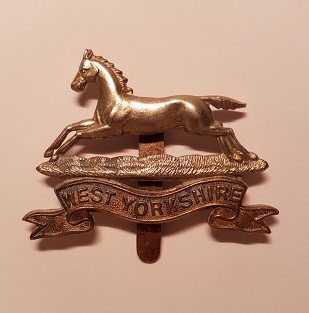
The West Yorkshire Regiment (Prince of Wales's Own) (14th Foot) was an infantry regiment of the British Army. In 1958 it amalgamated with the East Yorkshire Regiment (15th Foot) to form the Prince of Wales's Own Regiment of Yorkshire which was, on 6 June 2006, amalgamated with the Green Howards and the Duke of Wellington's Regiment (West Riding) to form the Yorkshire Regiment (14th/15th, 19th and 33rd/76th Foot).

The South Lancashire Regiment was a line infantry regiment of the British Army in existence from 1881 to 1958.

The Cheshire Regiment was a line infantry regiment of the British Army, part of the Prince of Wales' Division. The 22nd Regiment of Foot was raised by the Henry Howard, 7th Duke of Norfolk in 1689 and was able to boast an independent existence of over 300 years. The regiment was expanded in 1881 as part of the Childers Reforms by the linking of the 22nd (Cheshire) Regiment of Foot and the militia and rifle volunteers of Cheshire. The title 22nd (Cheshire) Regiment continued to be used within the regiment.
The Devonshire and Dorset Regiment, usually just known as the Devon and Dorsets, was an infantry regiment of the British Army formed in 1958 by the amalgamation of two county regiments, the Devonshire Regiment and the Dorset Regiment. In 2007 it was itself merged into The Rifles, a "large regiment". Members of the regiments referred to themselves as being a Janner.

The Dorset Regiment was a line infantry regiment of the British Army in existence from 1881 to 1958, being the county regiment of Dorset. Until 1951, it was formally called the Dorsetshire Regiment, although usually known as "The Dorsets". In 1958, after service in the Second Boer War along with World War I and World War II, the Dorset Regiment was amalgamated with the Devonshire Regiment to form the Devonshire and Dorset Regiment. In 2007, it was amalgamated with the Royal Gloucestershire, Berkshire and Wiltshire Regiment, The Light Infantry and the Royal Green Jackets to form a new large regiment, The Rifles.

The Buffs (Royal East Kent Regiment), formerly the 3rd Regiment of Foot, was a line infantry regiment of the British Army traditionally raised in the English county of Kent and garrisoned at Canterbury. It had a history dating back to 1572 and was one of the oldest regiments in the British Army, being third in order of precedence (ranked as the 3rd Regiment of the line). The regiment provided distinguished service over a period of almost four hundred years accumulating one hundred and sixteen battle honours. In 1881, under the Childers Reforms, it was known as the Buffs (East Kent Regiment) and later, on 3 June 1935, was renamed the Buffs (Royal East Kent Regiment).
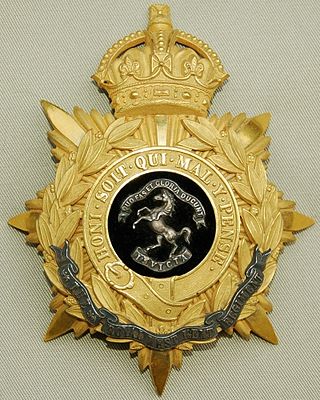
The Queen's Own Royal West Kent Regiment was a line infantry regiment of the British Army based in the county of Kent in existence from 1881 to 1961. The regiment was created on 1 July 1881 as part of the Childers Reforms, originally as the Queen's Own (Royal West Kent Regiment), by the amalgamation of the 50th (Queen's Own) Regiment of Foot and the 97th (The Earl of Ulster's) Regiment of Foot. In January 1921, the regiment was renamed the Royal West Kent Regiment (Queen's Own) and, in April of the same year, was again renamed, this time as the Queen's Own Royal West Kent Regiment.
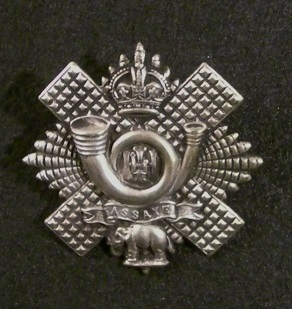
The Highland Light Infantry (HLI) was a light infantry regiment of the British Army formed in 1881. It took part in the First and Second World Wars, until it was amalgamated with the Royal Scots Fusiliers in 1959 to form the Royal Highland Fusiliers which later merged with the Royal Scots Borderers, the Black Watch, the Highlanders and the Argyll and Sutherland Highlanders to form the Royal Regiment of Scotland, becoming the 2nd Battalion of the new regiment.
The Rifles is an infantry regiment of the British Army. Formed in 2007, it consists of four Regular battalions and three Reserve battalions. Each Regular battalion of The Rifles was formerly an individual battalion of one of the two large regiments of the Light Division. Since formation, the regiment has been involved in combat operations in the later stages of the Iraq War and in the War in Afghanistan.

The Royal Warwickshire Regiment, previously titled the 6th Regiment of Foot, was a line infantry regiment of the British Army in continuous existence for 283 years. The regiment saw service in many conflicts and wars, including the Second Boer War and both the First and Second World Wars. On 1 May 1963, the regiment was re-titled, for the final time, as the Royal Warwickshire Fusiliers and became part of the Fusilier Brigade.
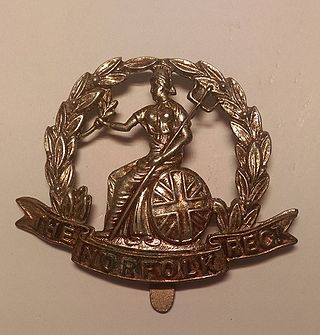
The Royal Norfolk Regiment was a line infantry regiment of the British Army until 1959. Its predecessor regiment was raised in 1685 as Henry Cornwall's Regiment of Foot. In 1751, it was numbered like most other British Army regiments and named the 9th Regiment of Foot.
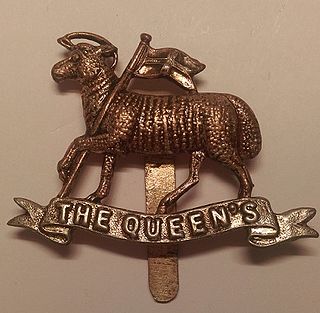
The Queen's Royal Regiment (West Surrey) was a line infantry regiment of the English and later the British Army from 1661 to 1959. It was the senior English line infantry regiment of the British Army, behind only the Royal Scots in the British Army line infantry order of precedence.

The Leicestershire Regiment was a line infantry regiment of the British Army, with a history going back to 1688. The regiment saw service for three centuries, in numerous wars and conflicts such as both World War I and World War II, before being amalgamated, in September 1964, with the 1st East Anglian Regiment, the 2nd East Anglian Regiment and the 3rd East Anglian Regiment to form the present day Royal Anglian Regiment, of which B Company of the 2nd Battalion continues the lineage of the Royal Leicestershire Regiment.
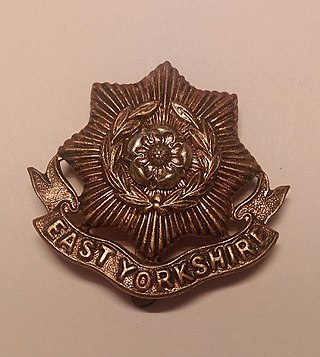
The East Yorkshire Regiment was a line infantry regiment of the British Army, first raised in 1685 as Sir William Clifton's Regiment of Foot and later renamed the 15th Regiment of Foot. It saw service for three centuries, before eventually being amalgamated with the West Yorkshire Regiment in 1958, to form the Prince of Wales's Own Regiment of Yorkshire. Subsequently, the regiment amalgamated with the Green Howards and the Duke of Wellington's Regiment to form the Yorkshire Regiment on 6 June 2006.

The Suffolk Regiment was an infantry regiment of the line in the British Army with a history dating back to 1685. It saw service for three centuries, participating in many wars and conflicts, including the First and Second World Wars, before being amalgamated with the Royal Norfolk Regiment to form the 1st East Anglian Regiment in 1959 which, in 1964, was further amalgamated with the 2nd East Anglian Regiment, the 3rd East Anglian Regiment and the Royal Leicestershire Regiment to create the present Royal Anglian Regiment.

The King's Own Royal Regiment (Lancaster) was a line infantry regiment of the British Army. It served under various titles and fought in many wars and conflicts, including both the First and the Second World Wars, from 1680 to 1959. In 1959, the regiment was amalgamated with the Border Regiment to form the King's Own Royal Border Regiment.
The 136th Infantry Brigade was an infantry brigade of the Territorial Force, part of the British Army. It was formed in the First World War as a duplicate of the Devon and Cornwall Brigade and was originally formed as the 2nd/1st Devon and Cornwall Brigade in 1914–1915 before later being renamed as the 136th Brigade. It was sent overseas to India in December 1914 to relieve Regular Army units for service in France. The brigade remained there for the rest of the war, supplying drafts of replacements to the British units fighting in the Middle East and later complete battalions.

The Exeter & South Devon Volunteers was the premier unit of Britain's Volunteer Force. Formed in 1852 it went on to become a battalion of the Devonshire Regiment. Both its active service battalions went to garrison India on the outbreak of the First World War, and then saw action in Mesopotamia and Palestine. In the Second World War, the battalion served in the garrison of Gibraltar. It continued in the postwar Territorial Army until it was merged with other West Country units. Its successors today serve in a reserve battalion of The Rifles.
























